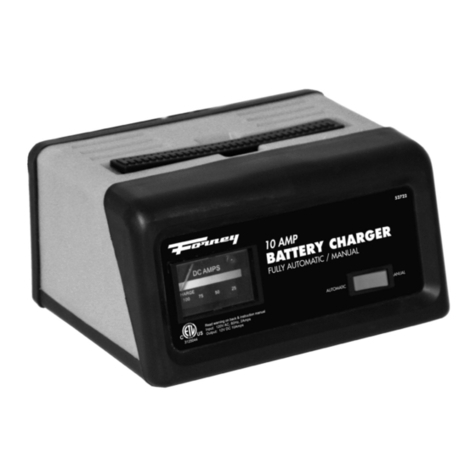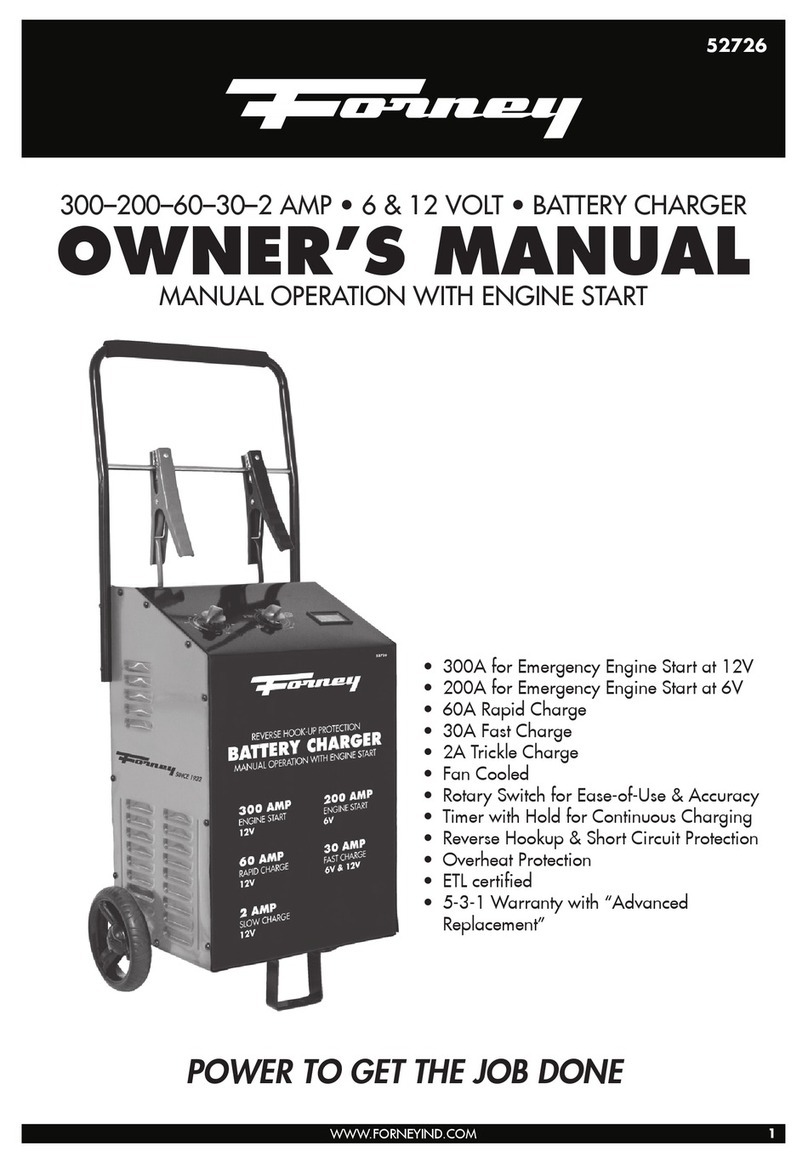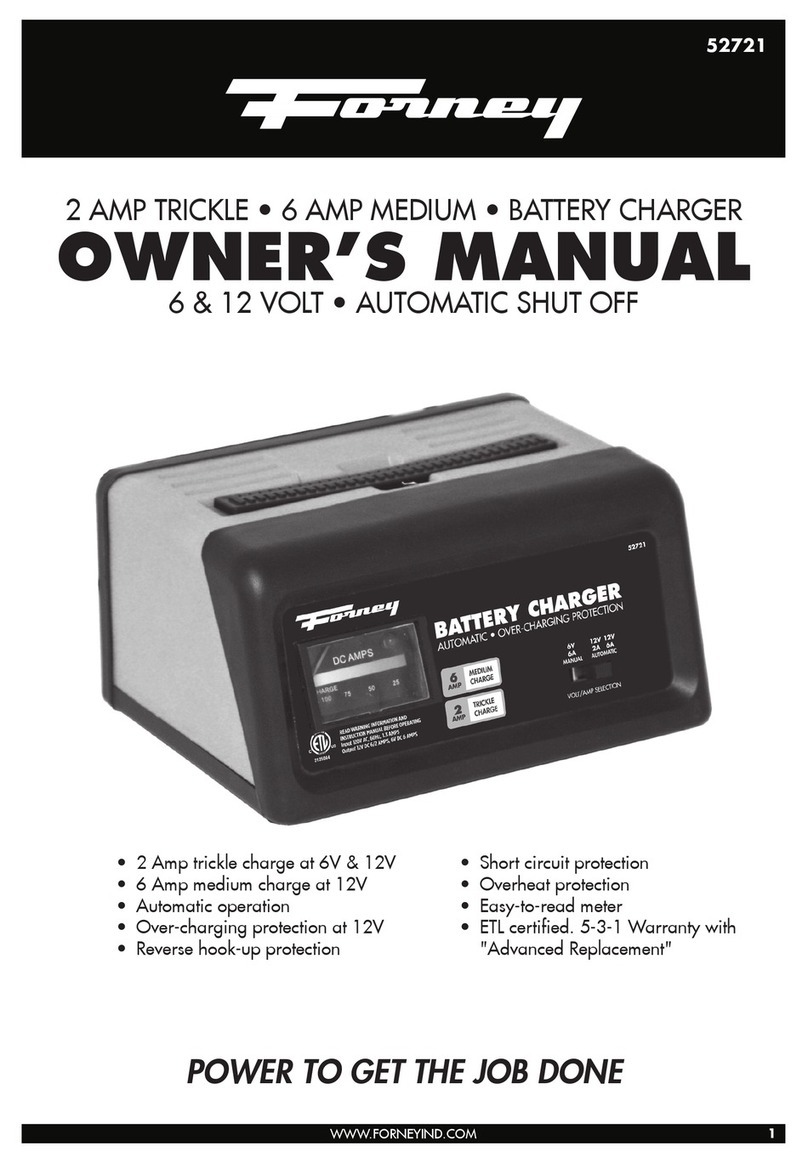Forney 52755 User manual

52755
6V 2A, 40A BOOST 12V 2A, 10A, 40A BOOST
12V 200A ENGINE START
WHEEL BATTERY CHARGER
POWER TO GET THE JOB DONE™
OWNER’S MANUAL
• Short Circuit Protected
• Reverse Polarity Protected
• Overheat Protected
• Spark Proof
• Overcharge Protected
• ETL Certified
• CEC/DOE Compliant
• 1 Year Warranty
• Electrical Rating 120 VAC / 60 Hz
10A Charge
ENGLISH


3
WWW.FORNEYIND.COM
Working in the vicinity of a lead-acid battery is dangerous. Batteries generate explosive gases during normal
battery operation. For this reason, it is of utmost importance that each time before using your charger, you read
this manual and follow the instructions exactly.
This unit contains or emits chemicals known to the State of California to cause cancer and birth defects or other
reproductive harm. Wash hands after handling.
IMPORTANT SAFETY INSTRUCTIONS
WARNING
1. SAVE THESE INSTRUCTIONS. This manual contains
important safety and operating instructions. You may
need to refer to these instructions at a later date.
2. CAUTION. To reduce risk of injury, charge only
wet cell, lead-acid, automotive type rechargeable
batteries. Other types of batteries may burst causing
personal injury and property damage.
3. Do not expose charger to rain or snow.
4. Use of an attachment not recommended or sold by
the battery charger manufacturer may result in a risk
of fire, electric shock, or injury to persons.
5. To reduce risk of damage to electric plug and cord,
pull by plug rather than cord when disconnecting
charger.
6. Make sure cord is located so that it will not be
stepped on, tripped over, or otherwise subjected to
damage or stress.
7. An extension cord should not be used unless
necessary. Use of improper extension cord could
result in a risk of fire and electric shock. If an
extension cord must be used, make sure:
a. That pins on plug of extension cord are the same
number, size, and shape as those of plug on
charger;
b. That extension cord is properly wired and in good
electrical condition; and
c. That wire size is large enough for AC ampere
rating of charger as specified in Table A
8. Do not operate charger with damaged cord or plug,
replace the cord or plug immediately.
9. Do not operate charger if it has received a sharp
blow, been dropped, or otherwise damaged in any
way; take it to a qualified service center.
10. Do not disassemble charger; take it to a qualified
service center when service or repair is required.
Incorrect reassembly may result in a risk of electric
shock or fire.
11. To reduce risk of electric shock, unplug charger from
outlet before attempting any maintenance or cleaning.
Turning off controls will not reduce this risk.
12. WARNING - RISK OF EXPLOSIVE GASES
To reduce risk of battery explosion, follow these
instructions and those published by the battery
manufacturer and the manufacturer of any equipment
you intend to use in the vicinity of the battery. Review
cautionary marking on these products and on engine.
Table A: Recommended minimum AWG size for extension
cords for battery chargers.
AC Input rating, amperes* AWG size of cord
Length of cord, feet
Equal to or
greater than But less than 25 50 100 150
8 10 18 14 12 10
10 12 16 14 10 8
12 14 16 12 10 8
14 16 16 12 10 8
16 18 14 12 8 8
18 20 14 12 8 6
* If the input rating of a charger is given in watts rather
than in amperes, the corresponding ampere rating is to be
determined by dividing the wattage rating by the voltage
rating – for example:
1250 watts/125 volts = 10 amperes

4
WWW.FORNEYIND.COM
PERSONAL PRECAUTIONS
SPECIFICATIONS
1. Consider having someone close enough by to come
to your aid when you work near a lead-acid battery.
2. Have plenty of fresh water and soap nearby in case
battery acid contacts skin, clothing, or eyes.
Wear ANSI-approved splash-resistant safety
goggles and heavy-duty rubber work gloves
whenever connecting, disconnecting, or working
near battery. Battery acid can cause permanent
blindness.
3. Wear complete eye protection, and protective
clothing. Avoid touching eyes while working near
battery.
4. If battery acid contacts skin or clothing, wash
immediately with soap and water. If acid enters
eye, immediately flood eye with running cold water
for at least 10 minutes and get medical attention
immediately.
5. NEVER smoke or allow a spark or flame near battery.
6. Be extra cautious to reduce risk of dropping a metal
tool onto battery. It might spark or short circuit
battery or other electrical part that may cause
explosion.
7. Remove personal metal items such as rings, bracelets,
necklaces, and watches when working with a lead-
acid battery. A lead-acid battery can produce a short
circuit current high enough to weld a ring or the like to
metal, causing a severe burn.
8. Use charger for charging a LEAD-ACID battery only.
a. It is not intended to supply power to a low-voltage
electrical system other than in a starter motor
application.
b. Do not use battery charger for charging dry-cell
batteries that are commonly used with home
appliances. These batteries may burst and cause
injury to persons and damage to property.
c. People with pacemakers should consult their
physician(s) before use. Electromagnetic fields in
close proximity to heart pacemaker could cause
pacemaker interference or pacemaker failure.
In addition, people with pacemakers should:
• Avoid operating alone.
• Properly maintain and inspect to avoid electrical
shock.
• Properly ground power cord. Ground Fault
Circuit Interrupter (GFCI) should also be
implemented. – it prevents sustained electrical
shock.
9. NEVER charge a frozen battery.
The warnings, precautions, and instructions discussed
in this instruction manual cannot cover all possible
conditions and situations that may occur. It must be
understood by the operator that common sense and
caution are factors which cannot be built into this
product, but must be supplied by the operator.
Electrical Rating 120VAC / 60Hz / 10A (40A for boost)
Charge Settings
6V 12V
2A
40A Boost 2A
10A
40A
Boost
Starter Settings 12V, 200A
5 second maximum with 180 second rest
Battery Cables 6'
Red = Positive
Black = Negative
Power Cord 6' 5"

5
WWW.FORNEYIND.COM
ASSEMBLY INSTRUCTIONS
Read the ENTIRE IMPORTANT SAFETY INFORMATION
section at the beginning of this manual; including all
text under subheadings therein, before set up or use of
this product.
TO PREVENT SERIOUS INJURY: Unplug the
charger, disconnect any battery, and allow
charger to cool completely before assembling
or making any adjustments to the charger.
1. Slide Wheel Bearing (if supplied) onto Axle.
2. Slide Wheel onto Axle.
3. Attach Hubcap to Axle by tapping gently with rubber
mallet (not included).
4. Repeat on other side
Attach Wheel Assembly
1. Lay Charger down.
2. Attach Wheel Assembly with two Brackets and four
tapping Screws.
Attach Foot
1. Attach Foot with four Tapping Screws.
Attach Handle
1. Insert handle into handle supports on back of
charger.
2. Locate holes in handle and insert threaded bolt and
tighten.
There are holes on the upper part of the handle for
storage and carrying purposes.
Hubcap Wheel
Wheel Bearing Axle
Bracket
Tapping Screw
Tapping Screw Foot
Table of contents
Languages:
Other Forney Batteries Charger manuals






















